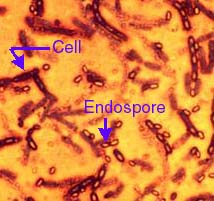|
Anthrax:
A Primer
 Anthrax
is caused by Bacillus anthracis. "Bacillus" is
from the Latin word describing the rod (little staff) shape. "Anthracis"
is from the Greek work for (black) coal. The bacterium has a cell
wall of the gram-positive type. Gram-positive bacteria are usually
susceptible to penicillin. Anthrax
is caused by Bacillus anthracis. "Bacillus" is
from the Latin word describing the rod (little staff) shape. "Anthracis"
is from the Greek work for (black) coal. The bacterium has a cell
wall of the gram-positive type. Gram-positive bacteria are usually
susceptible to penicillin.
This
bacterium makes endospores or "spores." Normally, when
food is available, a bacterial cell grows and duplicates its chromosome,
then the cell divides. The two daughter cells grow, duplicate
their chromosomes and continue the cycle until the food it depleted
or the environment no longer favors growth.
Instead
of dividing into two daughter cells, Bacillus bacteria
sometimes wall off the chromosome in a thick cell wall to produce
an endospore. Vegetative cells have poor survival outside of an
animal host, dying within 24 hours in water. However, the endospore
can survive long periods of drought, heat, cold, toxic chemicals,
and ultraviolet radiation. When a cell produces an endospore it
is no longer reproducing but it will survive in an environment
that kills the vegetative cells. During favorable conditions such
as abundant amino acids and glucose found in animal blood or tissues,
the spores germinate to produce a growing colony of cells.
|